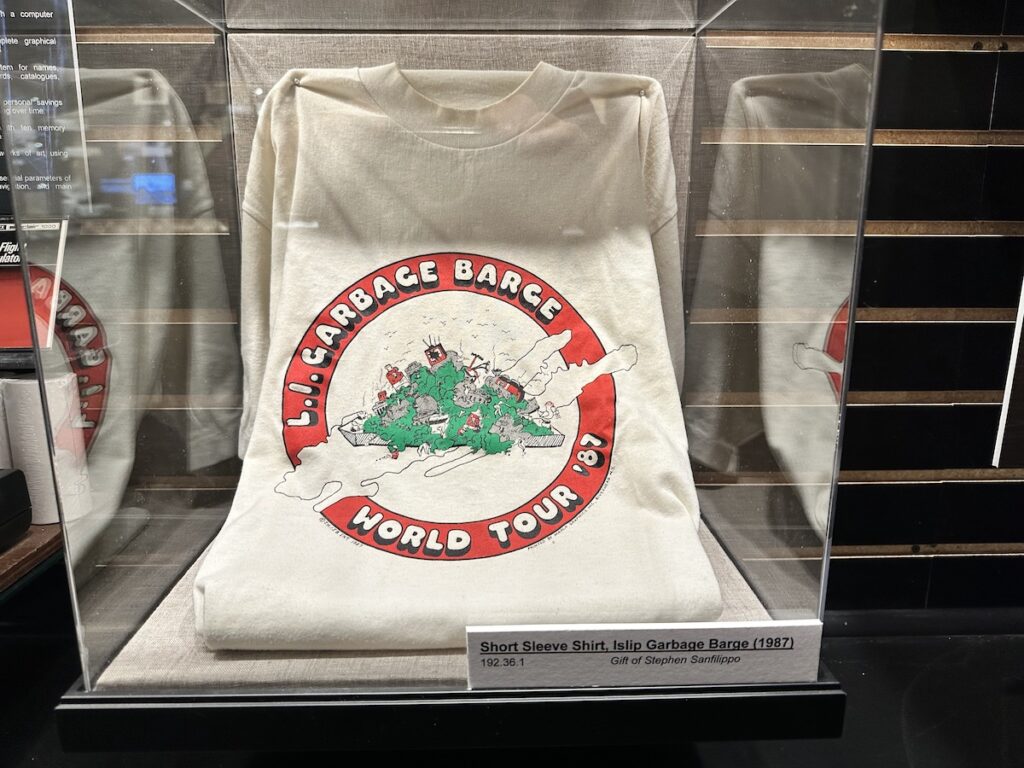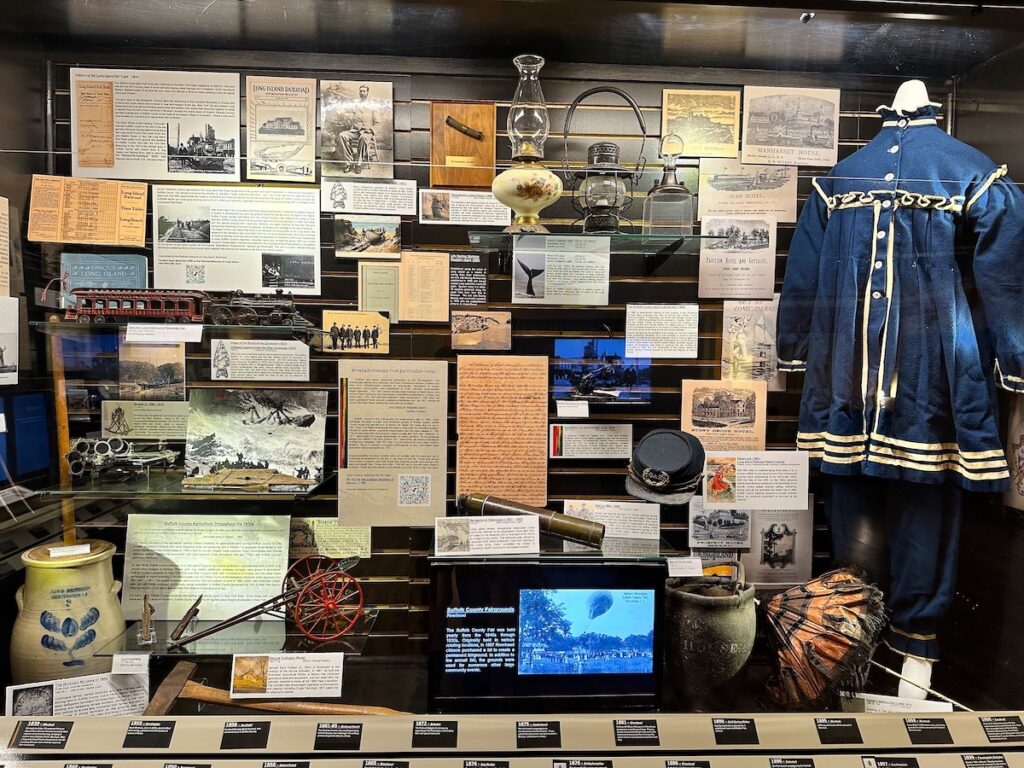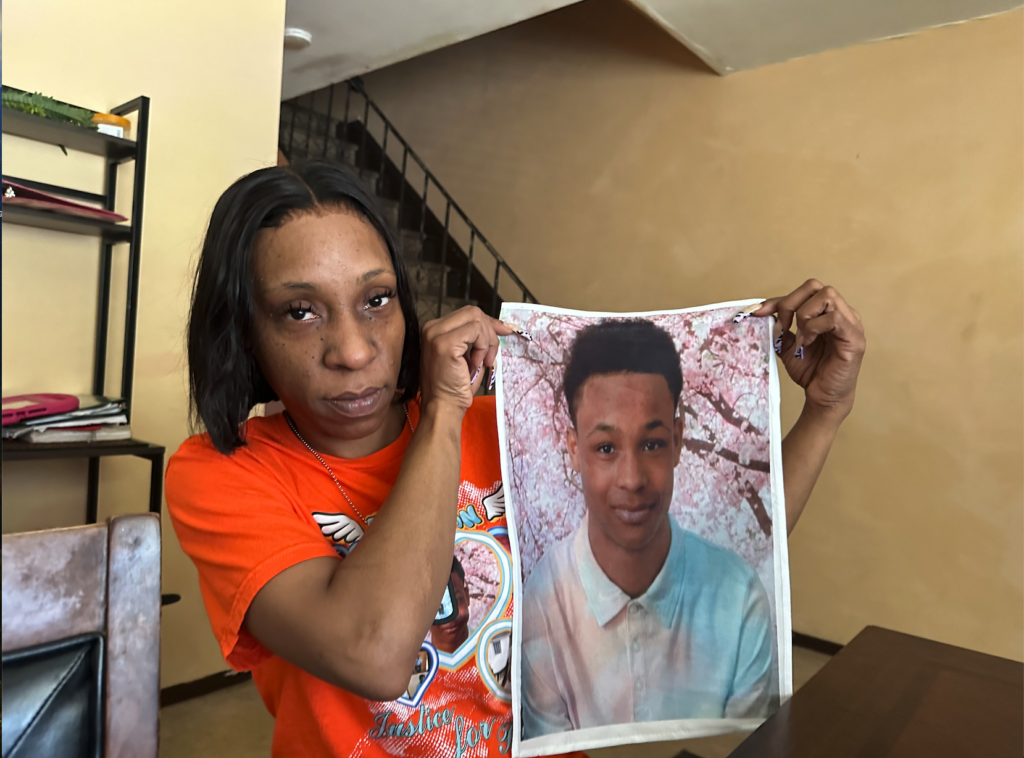Suffolk County history comes alive in ambitious new exhibit

Imagine trying to chronicle the entire history of Suffolk County inside a 30 by 35-foot room.
Over the weekend, the Suffolk County Historical Society Museum in Riverhead launched its most ambitious exhibit ever — a timeline of the 200 most pivotal moments in county history, with scores of intriguing artifacts stretching from the county’s earliest settlers through several wars and waves of migration and ultimately to the final item on the timeline: the 2010 federal recognition of the Shinnecock Native American tribe.
“I call it our museum-within-a-museum,” said Victoria Berger, the museum’s executive director. “The whole history of Suffolk County is in there.”
Three years in the making, this multi-tiered, storybook exhibit opens with Long Island’s geological formation during the Paleozoic era, pivots nimbly to the arrival 12,000 years ago of the region’s first human inhabitants — Paleo-Indians from Asia — and the seven-year British occupation of Long Island during the Revolutionary War.
The exhibit also spotlights a witch trial, the expansion of slavery and later abolition efforts on Eastern Long Island, the birth of the Long Island Railroad, the Civil War, the golden age of whaling, rum-running, farming, the Vietnam war, the founding of Suffolk County, the Brookhaven National Lab, the infamous 1980s garbage barge, the 1995 Pine Barrens wildfires, 9/11 and the recognition of the Shinnecock Nation.
“We looked at every aspect of Suffolk County,” Ms. Berger said. “We looked at it from an industrial level, from an agricultural level, from a recreational level. We looked at … the people, the heritage, the Native Americans, the African Americans, each wave of immigration coming into Suffolk County, the first people that settled here from abroad, we looked at the natural history.
“By tackling [the project] from each vantage point, we were able to pull out historically significant moments and add them to the timeline.”

Ms. Berger said that most of the artifacts have been sitting in “preservation storage” for decades and have never before been displayed in public.
The exhibit also features tantalizing true crime stories and colonial era intrigue.
In 1658 in East Hampton — decades before the Salem witch trials — Elizabeth “Goody” Garlick was accused by Elizabeth Gardiner Howell, the fever-ravaged, delirious daughter of local powerbroker Lion Gardiner, of casting a spell on her. She died the next day and all across East Hampton the knives came out for Ms. Garlick. She was accused of being a witch, according to the exhibit.
Yet Mr. Gardiner and the rest of his family knew her well, as her husband was an employee of the wealthy landowners. They knew she wasn’t a witch and wasn’t responsible for their daughter’s death. They also knew she wasn’t safe in East Hampton.
Mr. Gardiner pulled political strings and had her case moved to a Connecticut court, where he knew she’d be acquitted for lack of evidence. Upon her return to Long Island, the Gardiners harbored her from harm with an invitation to live out her days in the security — and solitude — of Gardiner’s Island.
The exhibit also features the pole axe used in the notorious 1854 Wickham murders, in which Cutchogue farmer James Wickham and his wife Frances and a young farmhand were bludgeoned to death by a disgruntled employee recently fired for drinking and harassing women. The “belligerent” perpetrator, Nicholas Bain (or Behan, according to some accounts), was caught, tried and executed by hanging in Riverhead. The murder weapon was an undated gift to the museum from a Ms. Septer Luce, according to the exhibit.
After Mr. Bain’s hanging, “they didn’t have a proper repository for [the murder weapon], so it ended up here,” Ms. Berger said. “It wasn’t like they had evidence rooms back then.”
In other instances, she said, “we don’t know the history of how things ended up here.”
In depth odysseys along the timeline’s path chronicle the first English settlements (1640, Southold and Southampton); the arrival of the county’s first enslaved people (1654, on Shelter Island); the statewide abolition of slavery (1827); the first Black church congregation (1885, Amityville); the first Jewish settlers (1705, in Brookhaven) the first Jewish congregation (1875, in Lindenhurst); and many more.
George Washington toured Long Island in 1790 and 1881 saw the opening of an opera house, the Vail-Leavitt Music Hall, now the oldest theater on Long Island and New York City. The historic theater on Peconic Avenue in Riverhead regularly hosted Thomas Edison, who “frequented the hall as he worked to synchronize sound and film,” an innovation that fueled the birth of Hollywood.
The Long Island Railroad was chartered in 1834. The tracks reached Hicksville two years later, and arrived in Greenport in 1844.

The exhibit is permanent and forms the new core of the museum’s artifacts and histories, Ms. Berger said.
“What we really wanted to talk about is all the pinnacle moments that formed who we are, changed the trajectory of our focus,” she said, adding that the museum’s curators also “wanted to celebrate important institutions like Grumman [corporation], Brookhaven National Labs, Cold Spring Harbor Lab and their accomplishments.”
Throughout the project, the greatest challenge was space.
“With so much history, we are hindered by the physical space in the room,” she said, explaining how museum officials decided to stage it in a large room in the basement. “So we basically dedicated a century to each cabinet,” she said. At times the curators faced “painful decisions” of what to leave out and keep in, and “in a lot of areas we augmented the physical space by branching out to QR codes with online content. You can read more of the story by scanning the QR code” with your phone.”
Ms. Berger said she worked with seven other organizations “to get input and contributions to identify these pinnacle moments in this county, which of course begins with Native Americans, African Americans, we’re layering in some immigration history and identifying all the moments that made this county what it is today.”
She said that her staff, especially collections manager Richard Doctorow, was instrumental in seeing the massive project through to its completion.
“This was a full, hands-on project, and every member of the staff contributed,” she said. “It was a full team effort.”
The entire exhibit was funded by the Robert David Lion Gardiner Foundation with additional support from Roberta Cooper in memory of James B. Cooper III and the Cooper family, Ms. Berger said, putting the total price tag at about $40,000.
Ms. Berger said that the display is modular, so it can be further compressed to add more local history.
“It’s a permanent exhibit, but it’s kind of a living history. We will continue to add in additional layers. I want more immigration pattern histories. As historians … we’re always uncovering new stones and finding new things and we wanted this [exhibit] to grow with us.”
The museum, located at 300 W. Main Street in Riverhead, is open Wednesday through Saturday from 10 a.m to 4:30 p.m.








